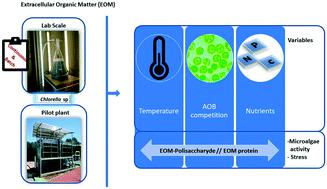当前位置:
X-MOL 学术
›
Environ. Sci.: Water Res. Technol.
›
论文详情
Our official English website, www.x-mol.net, welcomes your
feedback! (Note: you will need to create a separate account there.)
Production of microalgal external organic matter in a Chlorella-dominated culture: influence of temperature and stress factors
Environmental Science: Water Research & Technology ( IF 3.5 ) Pub Date : 2020-05-13 , DOI: 10.1039/d0ew00176g J. González-Camejo 1, 2, 3, 4 , M. Pachés 1, 2, 3, 4 , A. Marín 1, 2, 3, 4 , A. Jiménez-Benítez 1, 2, 3, 4 , A. Seco 1, 4, 5, 6, 7 , R. Barat 1, 2, 3, 4
Environmental Science: Water Research & Technology ( IF 3.5 ) Pub Date : 2020-05-13 , DOI: 10.1039/d0ew00176g J. González-Camejo 1, 2, 3, 4 , M. Pachés 1, 2, 3, 4 , A. Marín 1, 2, 3, 4 , A. Jiménez-Benítez 1, 2, 3, 4 , A. Seco 1, 4, 5, 6, 7 , R. Barat 1, 2, 3, 4
Affiliation

|
Although microalgae are recognised to release external organic matter (EOM), little is known about this phenomenon in microalgae cultivation systems, especially on a large scale. A study on the effect of microalgae-stressing factors such as temperature, nutrient limitation and ammonium oxidising bacteria (AOB) competition in EOM production by microalgae was carried out. The results showed non-statistically significant differences in EOM production at constant temperatures of 25, 30 and 35 °C. However, when the temperature was raised from 25 to 35 °C for 4 h a day, polysaccharide production increased significantly, indicating microalgae stress. Nutrient limitation also seemed to increase EOM production. No significant differences were found in EOM production under lab conditions when the microalgae competed with AOB for ammonium uptake. However, when the EOM concentration was monitored during continuous outdoor operation of a membrane photobioreactor (MPBR) plant, nitrifying bacteria activity was likely to be responsible for the increase in EOM concentration in the culture. Other factors such as high temperatures, ammonium-depletion and low light intensities could also have induced cell deterioration and thus have influenced EOM production in the outdoor MPBR plant. Membrane fouling seemed to depend on the biomass concentration of the culture. However, under the operating conditions tested, the behaviour of fouling rate with respect to the EOM concentration was different depending on the initial membrane state.
中文翻译:

小球藻为主的培养物中微藻外部有机物的产生:温度和压力因素的影响
尽管公认微藻会释放外部有机物(EOM),但在微藻培养系统中,尤其是大规模,对这种现象知之甚少。研究了温度,养分限制和铵氧化细菌(AOB)竞争等微藻胁迫因素对微藻生产EOM的影响。结果表明,在25、30和35°C的恒定温度下,EOM的产生具有非统计显着性差异。但是,当温度从25℃升高到35℃持续4天时,多糖产量显着增加,表明微藻胁迫。营养限制似乎也增加了EOM的产生。当微藻与AOB竞争铵吸收时,在实验室条件下的EOM生产中没有发现显着差异。然而,当在膜光生物反应器(MPBR)工厂连续室外运行期间监测EOM浓度时,硝化细菌的活性很可能是导致培养物中EOM浓度增加的原因。其他因素(例如高温,铵消耗和低光照强度)也可能导致细胞退化,从而影响了室外MPBR工厂的EOM生产。膜污染似乎取决于培养物中生物质的浓度。然而,在测试的操作条件下,结垢率相对于EOM浓度的行为取决于初始膜状态而有所不同。硝化细菌的活性可能是导致培养物中EOM浓度增加的原因。其他因素(例如高温,铵消耗和低光照强度)也可能导致细胞退化,从而影响了室外MPBR工厂的EOM生产。膜污染似乎取决于培养物的生物质浓度。然而,在测试的操作条件下,结垢率相对于EOM浓度的行为取决于初始膜状态而有所不同。硝化细菌的活性可能是导致培养物中EOM浓度增加的原因。其他因素(例如高温,铵消耗和低光照强度)也可能导致细胞退化,从而影响了室外MPBR工厂的EOM生产。膜污染似乎取决于培养物中生物质的浓度。然而,在测试的操作条件下,结垢率相对于EOM浓度的行为取决于初始膜状态而有所不同。膜污染似乎取决于培养物中生物质的浓度。然而,在测试的操作条件下,结垢率相对于EOM浓度的行为取决于初始膜状态而有所不同。膜污染似乎取决于培养物的生物质浓度。然而,在测试的操作条件下,结垢率相对于EOM浓度的行为取决于初始膜状态而有所不同。
更新日期:2020-07-02
中文翻译:

小球藻为主的培养物中微藻外部有机物的产生:温度和压力因素的影响
尽管公认微藻会释放外部有机物(EOM),但在微藻培养系统中,尤其是大规模,对这种现象知之甚少。研究了温度,养分限制和铵氧化细菌(AOB)竞争等微藻胁迫因素对微藻生产EOM的影响。结果表明,在25、30和35°C的恒定温度下,EOM的产生具有非统计显着性差异。但是,当温度从25℃升高到35℃持续4天时,多糖产量显着增加,表明微藻胁迫。营养限制似乎也增加了EOM的产生。当微藻与AOB竞争铵吸收时,在实验室条件下的EOM生产中没有发现显着差异。然而,当在膜光生物反应器(MPBR)工厂连续室外运行期间监测EOM浓度时,硝化细菌的活性很可能是导致培养物中EOM浓度增加的原因。其他因素(例如高温,铵消耗和低光照强度)也可能导致细胞退化,从而影响了室外MPBR工厂的EOM生产。膜污染似乎取决于培养物中生物质的浓度。然而,在测试的操作条件下,结垢率相对于EOM浓度的行为取决于初始膜状态而有所不同。硝化细菌的活性可能是导致培养物中EOM浓度增加的原因。其他因素(例如高温,铵消耗和低光照强度)也可能导致细胞退化,从而影响了室外MPBR工厂的EOM生产。膜污染似乎取决于培养物的生物质浓度。然而,在测试的操作条件下,结垢率相对于EOM浓度的行为取决于初始膜状态而有所不同。硝化细菌的活性可能是导致培养物中EOM浓度增加的原因。其他因素(例如高温,铵消耗和低光照强度)也可能导致细胞退化,从而影响了室外MPBR工厂的EOM生产。膜污染似乎取决于培养物中生物质的浓度。然而,在测试的操作条件下,结垢率相对于EOM浓度的行为取决于初始膜状态而有所不同。膜污染似乎取决于培养物中生物质的浓度。然而,在测试的操作条件下,结垢率相对于EOM浓度的行为取决于初始膜状态而有所不同。膜污染似乎取决于培养物的生物质浓度。然而,在测试的操作条件下,结垢率相对于EOM浓度的行为取决于初始膜状态而有所不同。










































 京公网安备 11010802027423号
京公网安备 11010802027423号